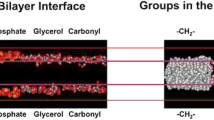Summary
The formation and properties of mono- and bimolecular films of total lipids extracted from an axolemma-rich preparation from retinal axons of the squid are described.
The bilayers formed with α-tocopherol showed resistance values of 107 Ω cm2 indicating their low ionic permeability. These membranes were stable for 30 to 60 min and they behave as an ohmic resistance in the range of −120 to +120 mV.
The films formed with these lipids did not discriminate between Na+ and K+ and showed a slight selectivity for Cl− as compared with cations, indicating a behavior as a rather neutral barrier.
The pressure-area characteristics of monolayers built with the phospholipids fraction gave an area of 79 Å2/molecule at a pressure of 10 dynes/cm. This expanded molecular area can be accounted for by the unsaturated fatty acid chains of polyenoic structure attached to these phospholipid molecules. The fraction containing 81% cholesterol presented an area of 29 Å2/molecule at 10 dynes/cm.
Monolayers of the total lipids displayed an area of 51.7 Å2/molecule at a pressure of 10 dynes/cm. These findings indicate that the phospholipids, when mixed with cholesterol and free fatty acids, formed rather condensated films. Cholesterol might contribute significantly to increase the cohesive forces in the film and hence to its stability.
The expanded films given by the phospholipids extracted from nerve membrane also indicate that they have a low transition temperature; their unusual unsaturated aliphatic chains might be in a special high mobile condition. Their behavior might be important for the position and order of polar groups in an excitable membrane.
Similar content being viewed by others
References
Andreoli, T. E., Bangham, J. A., Tosteson, D. C. 1967. The formation and properties of thin lipid membranes from HK and LK sheep red cell lipids.J. Gen. Physiol. 50:1729.
Cass, A., Finkelstein, A. 1967. Water permeability of thin lipid membranes.J. Gen. Physiol. 50:1765.
Chapman, D., Owens, N. F., Phillips, M. C., Walker, D. A. 1969. Mixed monolayers of phospholipids and cholesterol.Biochem. Biophys. Acta 183:458.
Demel, R. A., Van Deenen, L. L., Pethica, B. A. 1967. Monolayers interactions of cholesterol and phospholipids.Biochem. Biophys. Acta 135:11.
Fischer, S., Cellino, M., Zambrano, F., Zampighi, G., Téllez-Nagel, I., Marcus, D., Canessa-Fischer, M. 1970. The molecular organization of nerve membranes. I. Isolation and characterization of plasma membranes from the retinal axons of the squid: an axolemma-rich preparation.Arch. Biochem. Biophys. 138:1.
Hanai, T., Haydon, D. A., Taylor, J. 1965. Polar group orientation and the electrical properties of lecithin bimolecular leaflets.J. Theoret. Biol. 9:278.
Henn, F. A., Thompson, T. E. 1969. Synthetic lipid bilayers.Ann. Rev. Biochem. 38:241.
Hess, H. H., Lewing, E. 1965. Microassay of biochemical structural components in nervous tissues. II. Methods for cerebrosides, proteolipids, proteins and residue proteins.J. Neurochem. 12:205.
Hopfer, U., Lehninger, A. L., Lennarz, W. J. 1970. The effect of the polar moiety of lipids on the ion permeability of bilayer membranes.J. Membrane Biol. 2:41.
Huang, C., Wheeldon, C., Thompson, T. E. 1964. Properties of lipid bilayer membranes separating two aqueous phases: formation of a membrane of simple composition.J. Mol. Biol. 8:148.
Laüger, P., Lesslauer, W., Marti, E., Richter, J. 1967. Electrical properties of bimolecular phospholipid membranes.Biochem. Biophys. Acta 135:20.
Mueller, P., Rudin, D. O. 1968. Resting and action potentials in experimental bimolecular lipid membranes.J. Theoret. Biol. 18:222.
——, Tien, H. T., Wescott, W. C. 1962. Reconstitution of excitable cell membrane structure in vitro.Circulation 26:1167.
O'Brien, J. S. 1967. Cell membranes composition: structure: function.J. Theoret. Biol. 15:307.
Rouser, G., Nelson, G. J., Fleischer, S. 1968. Lipid composition of animal cell membranes, organelles and organs.In: Biological Membranes. D. Chapman, editor. p. 5. Academic Press Inc., New York.
Szabo, G., Eisenman, G., Ciani, S. 1969. The effects of the macrotetralide actin antibiotics on the electrical properties of phospholipid bilayer membranes.J. Membrane Biol. 1:346.
Ting, H. P., Huemoeller, W. A., Lalitha, S., Diana, A. L., Tien, H. T. 1968. Properties of black lipid membranes of chloroplast pigments.Biochem. Biophys. Acta 163:439.
Villegas, R., Camejo, G. 1968. Tetrodotoxin interaction with squid nerve membrane lipids.Biochim. Biophys. Acta 163:421.
Zambrano, F., Cellino, M., Canessa-Fischer, M. 1971. The molecular organization of nerve membranes. IV. The lipid composition of plasma membranes from retinal axons of the squid.J. Membrane Biol. 6:289.
Author information
Authors and Affiliations
Rights and permissions
About this article
Cite this article
Wolff, D., Canessa-Fischer, M., Vargas, F. et al. The molecular organization of nerve membranes. J. Membrain Biol. 6, 304–314 (1971). https://doi.org/10.1007/BF02116576
Received:
Issue Date:
DOI: https://doi.org/10.1007/BF02116576




